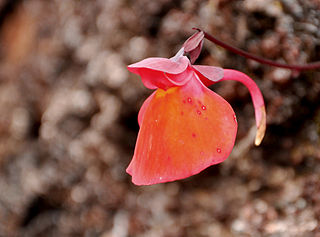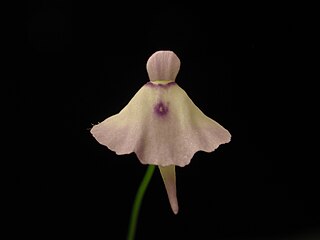
Utricularia inflata, commonly known as the swollen bladderwort, inflated bladderwort, or large floating bladderwort, is a large suspended aquatic carnivorous plant that belongs to the genus Utricularia. It is a perennial that is native to the southeastern coastal plains of the United States. It has often been confused with U. radiata, which is similar but smaller than U. inflata. Since 1980, U. inflata has been reported to exist in locations beyond its traditional range, such as the Adirondack Mountains in New York, southeastern Massachusetts, and in Washington State. Studies on the populations in the Adirondacks suggest that an introduction of U. inflata to a location where it naturalizes can lead to altered sediment chemistry by reducing the net primary productivity of native species. It is also listed by the state of Washington as a problematic species because of the dense mat-forming habit of this aquatic Utricularia. It is one of the few carnivorous plants that can be invasive.
Utricularia naviculata is a very small, annual suspended aquatic carnivorous plant that belongs to the genus Utricularia. It is a very distinct species with relatively large bracts and unique trap-bearing shoots ("leaves"). U. naviculata is endemic to South America and is known only from the type location in Venezuela and a single collection in Brazil. It is found at low altitudes in slow-flowing or still waters. It has been found flowering in Brazil during the month of May and in Venezuela during August. It was first formally described by Peter Taylor in 1967.
Utricularia stygia, the arctic bladderwort or Northern bladderwort, is an affixed aquatic carnivorous plant that belongs to the genus Utricularia. U. stygia is native to northern Europe and North America. This species was originally published by Göran Thor in 1987 but the description was not in Latin and was therefore nomenclaturally invalid. Thor validly published the species a year later. The cited difference that separates U. stygia from U. ochroleuca is the shape of the tiny quadrifid glands inside the bladders, specifically at which angle the "arms" of these glands diverge from one another. Thor, when working on the Utricularia of Sweden noted that this distinction alone allowed for consistent species identification. Both Barry Rice and Peter Taylor have expressed concerns regarding how this method applies to other populations around the world.
Utricularia panamensis is a small carnivorous plant that belongs to the genus Utricularia. U. panamensis, a lithophyte, is endemic to Panama and is only known from the type location and other collections in the same area. It was first described by Peter Taylor in 1977 as Utricularia sp. and later published as U. panamensis in 1986.
Utricularia schultesii is a small, terrestrial, perennial carnivorous plant that belongs to the genus Utricularia. U. schultesii is endemic to South America, where it is only known from the type location in Colombia and additional collections in Venezuela. It was published and described by Alvaro Fernández-Pérez in 1964.
Utricularia buntingiana is a small epiphytic, perennial carnivorous plant that belongs to the genus Utricularia. U. buntingiana is endemic to Venezuela, where it is only known from a few locations: the type location in Henri Pittier National Park, one collection on the Paraguaná Peninsula, and a few others from Falcón. It was originally published and described by Peter Taylor in 1975. Its habitat is reported as being mossy trees in montane forests at altitudes from 830 metres (2,723 ft) to 1,775 metres (5,823 ft). It has been seen flowering in June and July. Both U. buntingiana and U. praetermissa possess a double-curved corolla spur.

Utricularia quelchii is a small perennial, epiphyte or terrestrial carnivorous plant that belongs to the genus Utricularia. U. quelchii is endemic to the Guyana Highland region of Guyana and Venezuela with one collection from Brazil. It was originally published and described by N. E. Brown in 1901. It grows on wet, mossy rocks or banks in swamps and around low tree trunks and branches and sometimes in the water-filled leaf axils of the bromeliad Brocchinia species. It is typically found at altitudes around 2,000 m (6,562 ft), but has been recorded from altitudes of 1,400 m (4,593 ft) to 2,800 m (9,186 ft), the highest collections representing specimens from Roraima.
Utricularia podadena is a small, probably perennial, terrestrial carnivorous plant that belongs to the genus Utricularia and is the only member of Utricularia sect. Candollea. U. podadena is endemic to Malawi and Mozambique, being known only from the type location in Malawi and from one other collection in Mozambique. As of Peter Taylor's 1989 monograph on the genus, more recent efforts to locate this species have failed. It was originally published and described by Taylor in 1964 and placed in its own section, Candollea, in 1986. It grows as a terrestrial plant in marshy grasslands in the presence of Loudetia species at altitudes of around 1,000 m (3,281 ft). It flowers in July. It is a very distinct plant in the genus with the long stipitate glandular trichomes covering the flower. Its affinities within the genus are not clear.
Utricularia peranomala is a very small, annual, bryophilous lithophytic carnivorous plant that belongs to the genus Utricularia. U. peranomala is endemic to China, where it is only known from the type location in the hilly northeastern part of Guangxi. It grows as a lithophyte on wet rocks in between mosses. It was originally described and published by Peter Taylor in 1986.
Utricularia heterochroma is a very small, possibly perennial, rheophytic carnivorous plant that belongs to the genus Utricularia. U. heterochroma is endemic to Venezuela, where it is known from the type location at Ptari-tepui, two collections from Toronó-tepui, one collection from Apacará-tepui, one collection from Serrania Guanay, and several collections from the Chimantá Massif. It grows as a rheophyte on wet sandstone cliffs near waterfalls among mosses at altitudes from 1,760 m (5,774 ft) to 2,450 m (8,038 ft). It was originally described and published by Julian Alfred Steyermark in 1953.

Utricularia pubescens is a small to medium-sized, probably annual, terrestrial or lithophytic carnivorous plant that belongs to the genus Utricularia and is the only member of Utricularia sect. Lloydia. U. pubescens is native to India, tropical Africa, and Central and South America. It was originally published and described by James Edward Smith in 1819 and placed in its own section, Lloydia, by Peter Taylor in 1986. It grows as a terrestrial or lithophytic plant in boggy grasslands in damp peaty soils at altitudes from sea level to 1,900 m (6,234 ft). This species possesses small peltate leaves, which are diagnostic for this species in the genus.
Utricularia purpureocaerulea is a small, probably perennial, carnivorous plant that belongs to the genus Utricularia. U. purpureocaerulea is endemic to the Brazilian states of Bahia, Goiás, and Minas Gerais and is only known from six collections in these locations. It grows as a terrestrial plant in damp, sandy soils among rocks at altitudes from 1,000 m (3,281 ft) to 1,600 m (5,249 ft). U. purpureocaerulea was originally described and published by Augustin Saint-Hilaire and Frédéric de Girard in 1838.

Utricularia arenaria is a small annual carnivorous plant that belongs to the genus Utricularia. It is native to tropical and southern Africa, where it can be found in Angola, Burundi, Cameroon, Côte d'Ivoire, the Democratic Republic of the Congo, Ethiopia, Gabon, Ghana, Kenya, Madagascar, Malawi, Mali, Mozambique, Nigeria, Senegal, Sierra Leone, South Africa, Sudan, Tanzania, Togo, Uganda, Zambia, and Zimbabwe. There has also been a single collection from central India in Madhya Pradesh. U. arenaria grows as a terrestrial plant in damp, sandy or peaty soils in swampy grasslands or marshes at altitudes from near sea level to 2,400 m (7,874 ft). It was originally described and published by Alphonse Pyrame de Candolle in 1844.
Utricularia microcalyx is a small to medium-sized annual carnivorous plant that belongs to the genus Utricularia. It is native to tropical Africa, where it can be found in the Democratic Republic of the Congo and Zambia. U. microcalyx grows as a terrestrial plant in damp, sandy or peaty soils in grasslands at altitudes from 1,200 m (3,937 ft) to 1,650 m (5,413 ft). It typically flowers between February and July. It was originally described and published by Peter Taylor in 1964 as a variety of U. welwitschii. Taylor elevated this variety to the species level in 1971.
Utricularia odontosepala is a small to medium-sized, probably annual, carnivorous plant that belongs to the genus Utricularia. It is native to tropical Africa, where it can be found in the Democratic Republic of the Congo, Malawi, and Zambia. U. odontosepala grows as a terrestrial plant in damp, peaty soils in grasslands at altitudes from 1,300 m (4,265 ft) to 2,200 m (7,218 ft). It typically flowers between April and September. It was originally described and published by Otto Stapf in 1912. Peter Taylor later reduced the species to a variety of U. welwitschii in 1964 but then reversed his decision and reestablished Stapf's original treatment of the species.
Utricularia cecilii is a small annual carnivorous plant that belongs to the genus Utricularia. It is endemic to an area around Mangalore in Karnataka state and is only known from the type location and one other collection from the same region. U. cecilii grows as a terrestrial plant in damp, shallow soils over laterite. It flowers in August and September. U. cecilii was originally described and published by Peter Taylor in 1984. This species is named in honor of Father Cecil Saldanha S.J., who had shown Taylor this species in 1981.
Utricularia letestui is a small, probably annual, carnivorous plant that belongs to the genus Utricularia. It is endemic to the Central African Republic and is only known from three collections. U. letestui grows as a terrestrial plant in seasonally flooded grasslands, usually at altitudes around 800 m (2,625 ft). It was originally described and published by Peter Taylor in 1989. It was named in honor of the French collector G. Le Testu.
Utricularia corynephora is a small, probably perennial, carnivorous plant that belongs to the genus Utricularia. Its native distribution includes Burma and Thailand and is only known from the type specimen from the southern peninsula of Burma and from a collection on the adjacent peninsula in Thailand. U. corynephora grows as a lithophyte on wet granite rock faces at altitudes from 180 m (591 ft) to 750 m (2,461 ft). It was originally described by Peter Taylor in 1986.
Utricularia garrettii is a small perennial carnivorous plant that belongs to the genus Utricularia. It is endemic to Thailand where it is only known from the type locality and represented by a single specimen. U. garrettii grows as a lithophyte on moist rocks at altitudes around 2,175 m (7,136 ft). It was originally described by Peter Taylor in 1986 from a collection by H. B. G. Garrett in 1910. As of Taylor's 1989 revision of his monograph, it had not been recollected since Garrett's original collection. It is most similar to U. striatula and can be easily confused for it.



